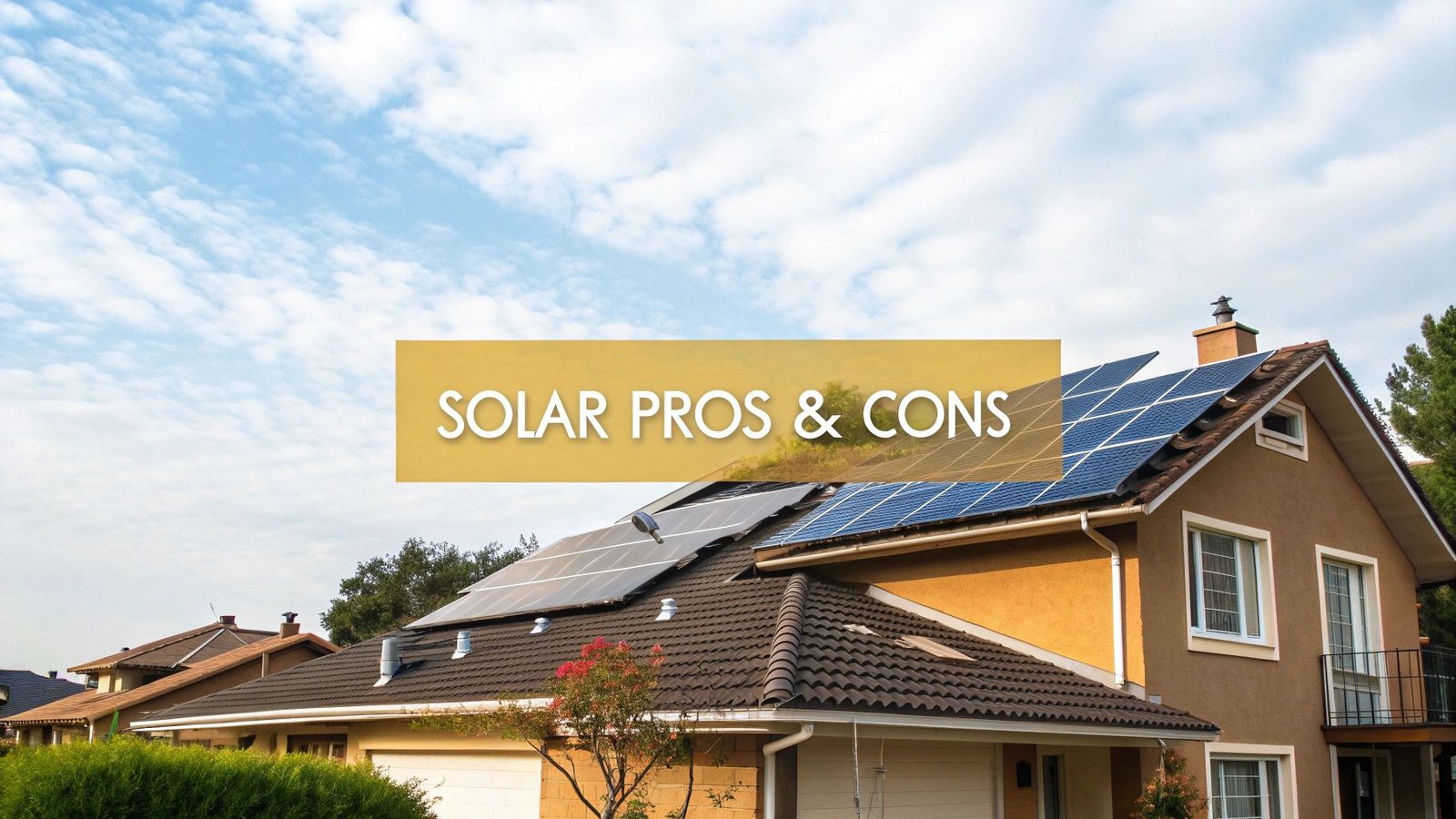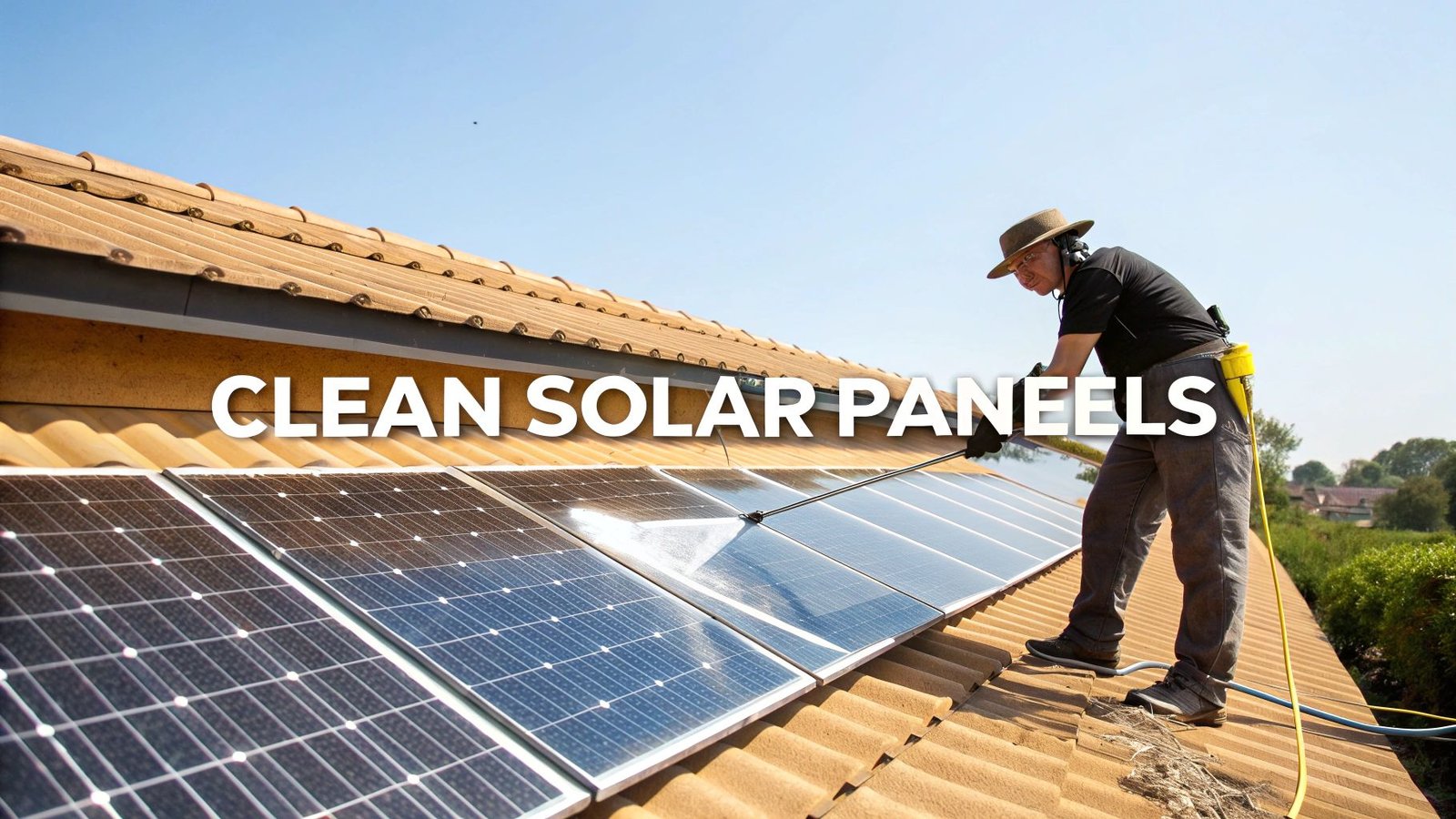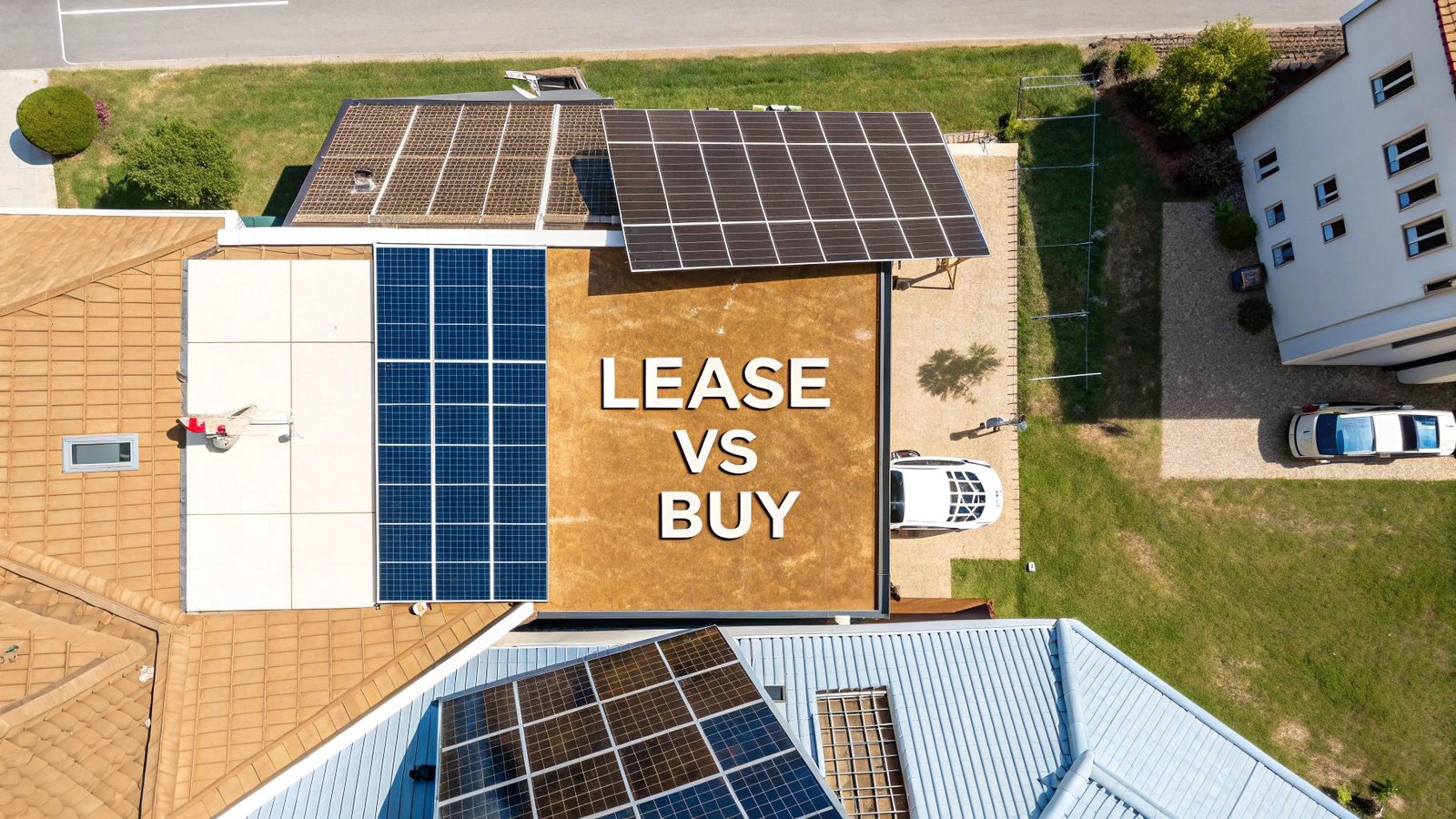It's a common question I hear: "How long will my solar panels actually last?" The good news is, most panels today are built like tanks, easily lasting 25 to 30 years.
But here's the key thing to understand: they don't just suddenly switch off one day. Instead, their ability to produce power slowly and predictably decreases over their lifetime. A top-tier panel you install today will still be cranking out about 80-85% of its original power even after 25 years of service.
The Real Lifespan of Modern Solar Panels
When you go solar, you're playing the long game. So, thinking about how long panels last isn't about pinpointing an expiration date; it's about understanding how well they perform over decades. It's a bit like an old, reliable car engine that might lose a little horsepower over the years but still runs perfectly fine.
This gradual dip in energy output has a name: degradation. It’s a completely normal part of a panel's life, caused by decades of exposure to UV radiation and the elements. The great thing is that this process is very slow and something manufacturers have studied for years.
Understanding Degradation Rates
The degradation rate is the single most important number for figuring out a panel's long-term value. Most quality panels today degrade at a rate of only 0.5% to 0.8% per year. It’s a tiny, almost unnoticeable drop year over year.
Do the math, and you'll see that after 25 years, that same panel is still operating at around 80% to 85% of its day-one capacity. This predictable performance is precisely why manufacturers feel comfortable offering 25-year performance warranties. They're essentially guaranteeing your investment is solid for the long haul. You can find more details on panel efficiency and longevity on EnergySage.com.
To give you a clearer picture, here’s a quick breakdown of what you can expect from a typical solar panel.
Solar Panel Performance At a Glance
This chart summarizes the key performance metrics you can expect from a typical solar panel over its lifespan.
graph TD
A[Typical Lifespan] --> B(25 to 30 years);
C[Annual Degradation Rate] --> D(0.5% - 0.8%);
E[Guaranteed Output @ Year 25] --> F(~85% of original capacity);
G[Standard Product Warranty] --> H(10 to 15 years);
As you can see, the numbers back up the story: modern solar panels are a durable, long-term investment in your energy future.
What Is Solar Panel Degradation?
Solar panel degradation is simply the slow, natural decline in energy output that every panel experiences over its lifetime. It’s a crucial concept to grasp, but don't worry—it’s not a sign that your panels are about to fail. They won't just stop working one day.
Think of it like a new car. The engine is at its peak performance when you first drive it off the lot. Over many years and thousands of miles, it might lose a tiny bit of its original horsepower, but it still gets you where you need to go reliably. Solar panels work the same way.
Years of soaking up the sun and enduring the weather cause a tiny, predictable drop in their ability to generate power. Most high-quality panels today have a degradation rate of just 0.5% per year. This decline is so gradual you'll never notice it in your daily energy production.
How Degradation Impacts Your Energy Production
So, what does that tiny percentage actually mean for your home's power supply down the road? With a 0.5% annual rate, your panels will still be working at about 95% of their original, out-of-the-box capacity after ten years. It’s this incredibly slow and predictable decline that makes solar such a solid long-term investment.
This chart gives you a great visual of what to expect over a typical 25-year lifespan.

As you can see, even after a quarter-century of tireless work, the system is still producing a huge amount of electricity. This isn’t just a hopeful estimate; it’s backed by one of the most important safeguards in the industry.
A performance warranty is the manufacturer's guarantee that their panels will maintain a certain level of efficiency over time. They typically promise the panels will still operate at 80-85% of their original output by year 25.
This warranty is your peace of mind, ensuring your investment is protected from any unusual drop in performance. It essentially builds this slow, expected degradation right into the plan. The science behind this amazing durability comes down to the materials inside the panels themselves. You can learn more about the different components of a solar panel to see how they’re built to last.
How Technology Made Solar Panels More Durable

Today's solar panels are genuine workhorses, built to last for decades. But it wasn't always this way. If you could time-travel back to look at panels made before the year 2000, you’d find a completely different story.
Early solar technology was exciting, but the panels themselves were far more fragile. They lost their ability to generate power at a much faster rate, not because the idea was flawed, but because the materials and manufacturing just weren't as advanced. Understanding this journey of improvement is crucial to seeing why a 25 to 30-year lifespan is now the industry benchmark.
The Leap in Durability and Efficiency
So, what exactly changed to make panels so much tougher? The real breakthroughs happened in the solar cells themselves and the protective layers that shield them from the elements. Manufacturing became incredibly precise, allowing companies to build panels that can withstand a quarter-century of sun, wind, rain, and snow.
Several key innovations are responsible for this dramatic slowdown in degradation:
- Better Encapsulants: The materials sealing the solar cells are now far more resistant to yellowing or cracking under constant UV exposure.
- Tougher Backsheets: The backing layer on modern panels provides a much stronger defense against moisture and physical stress.
- Advanced Cell Technology: Monocrystalline silicon cells, common today, are not only more efficient at making power but are also inherently more stable over the long haul.
These upgrades mean today’s panels are fundamentally more resilient. Research from the U.S. National Renewable Energy Laboratory (NREL) puts this progress into perspective. It found that panels made before 2000 lost about 1% of their output each year. In contrast, modern panels lose less than 0.4% annually.
gantt
title Degradation Rate Comparison: Pre-2000 vs. Modern Panels
dateFormat X
axisFormat %
section Pre-2000 Panels
Annual Rate :crit, 0, 1
section Modern Panels
Annual Rate : 0, 0.4
This graph shows the significant improvement in annual degradation rates.
Over 20 years, that’s the difference between an old panel operating at just 60-70% of its original capacity and a new one still humming along at 92%. You can dig deeper into these longevity findings on 8msolar.com.
This technological evolution is the reason the answer to "how long do solar panels last?" has changed so dramatically. That 25-year performance warranty isn't just a marketing gimmick; it's a guarantee backed by decades of real-world engineering.
Key Factors That Influence Panel Longevity
While 25 to 30 years is a solid benchmark, not all solar panels get there the same way. A few key things can make the difference between a system that performs beautifully for decades and one that quits early. It’s a bit like owning a car—how it’s built, where you drive it, and how well you take care of it all matter.
It all starts with quality. You wouldn't expect a budget car to last as long as a premium model, and the same logic applies here. Investing in panels from a well-known, reputable brand is your first line of defense.
Material Quality and Brand Reputation
Top-tier solar panels are built tough, using high-purity silicon, durable backsheets, and strong, tempered glass to protect the cells inside. The best manufacturers are constantly refining their products to stand up to decades of sun, wind, rain, and snow.
Picking a panel from an established company with a great warranty isn't just about paying for a name. It’s about peace of mind. These companies have a history of reliability and are far more likely to be around to honor their 25-year performance promise if you ever need them to.
Think of that initial choice as an insurance policy for your system’s future. But even the best-built panel needs to be able to handle its environment.
Environmental and Installation Factors
Where your panels live has a huge impact on their lifespan. A system basking in the mild California sun will face a lot less stress than one braving the intense desert heat of Arizona or the heavy snowfalls in Colorado. Constant high temperatures, for instance, can slowly speed up the aging of a panel's components.
But nothing matters more than a solid installation. A certified professional ensures your panels are mounted securely, wired correctly, and angled perfectly to catch the sun. A botched installation can undermine even the most expensive, high-quality panels, leading to all sorts of problems down the road.
To see how these elements work together, let's break them down. Some factors can wear a system down, while others build it up for the long haul.
Factors That Impact Solar Panel Durability
| Factor | Negative Impact (Shortens Lifespan) | Positive Impact (Extends Lifespan) |
|---|---|---|
| Panel Quality | Low-grade materials, poor manufacturing | Tier-1 brand, robust materials, strong warranty |
| Climate | Extreme heat, heavy snow, high humidity | Mild temperatures, moderate sun exposure |
| Installation | Improper mounting, faulty wiring | Certified professional, correct angling, secure racking |
As you can see, you have control over two of the three biggest factors: the quality of the panels you choose and the installer you hire. Getting these two right sets your solar investment up for success from day one.
Practical Tips to Maximize Your Solar Panel Lifespan

Once your solar panels are up on the roof, you're in the driver's seat when it comes to their long-term health. It’s a lot like owning a car—a little bit of preventative care goes a seriously long way. These simple habits are what will keep your system pumping out maximum power for its entire 25 to 30-year lifespan.
The single easiest and most effective thing you can do is keep your panels clean. Over time, a film of dust, pollen, and even bird droppings will build up, which literally shades the solar cells from the sun. This buildup not only cuts down on efficiency but can also create "hot spots" that stress the cells unnecessarily.
Proactive maintenance isn't about adding another chore to your weekend list. It's about protecting a major investment and making sure you get every last drop of energy you paid for. A little care ensures you maximize your return for decades.
Your Proactive Maintenance Checklist
Getting the most out of your system means staying on top of a few simple tasks. Following these essential solar panel maintenance tips is a great way to be a proactive solar owner.
-
Periodic Cleaning: For most homes, a simple rinse with a garden hose a few times a year is all it takes to wash away the grime. If you've got tougher buildup, you can learn more about https://radiantenergysolar.com/how-to-clean-solar-panels/ safely.
-
Annual Professional Inspections: It's a smart move to have a certified solar installer give your system a once-over every year. They'll check the wiring, racking, and all the connections to spot small issues before they can turn into bigger, more expensive problems.
-
Monitor Your System's Performance: Modern solar systems almost always come with a monitoring app for your phone or computer. Get in the habit of checking it. A sudden or steady dip in energy production is often the first sign that something needs a closer look.
By making these straightforward habits part of your routine, you can confidently answer the question "how long do solar panels last?" with "a very, very long time."
What Happens When Solar Panels Reach Retirement
So, what’s the final chapter for a solar panel after its 25 or 30-year run? It’s a common question, and thankfully, the answer isn’t a trip to the landfill. A panel's "retirement" isn't an abrupt end—it's more like a gradual transition into a new role.
Even after three decades on a rooftop, most panels are still chugging along, producing a good amount of power. They just aren't as efficient as they were on day one. This makes them perfect for a second life in less demanding jobs.
Think of it this way: retired solar panels are often repurposed for smaller, off-grid projects. They can easily power outdoor lights, charge up tools in a shed, or provide a bit of electricity for a remote cabin. They still have plenty of juice left to give.
A Sustainable End-of-Life Cycle
For panels that are truly at the end of the road, the future is looking bright and sustainable. The solar panel recycling industry is growing fast, creating a circular economy where old panels are dismantled and their valuable materials are recovered.
Here’s a quick breakdown of what’s inside a typical panel and how well it can be recycled.
pie
title Material Composition of a Solar Panel
"Glass" : 75
"Aluminum" : 10
"Silicon" : 5
"Copper, Silver, Other" : 10
This circular approach is a huge win. It keeps panels out of landfills and cuts down on the need to mine for new raw materials, making solar a genuinely responsible choice from start to finish. The biggest challenge now is just scaling up these recycling efforts to handle the wave of panels that will be retiring soon.
The Environmental Protection Agency (EPA) estimates that by 2030, around 80 million panels will reach their end-of-life in the U.S. alone. The good news is that modern recycling techniques can recover up to 95% of a panel's weight, turning what could be a waste problem into a massive resource. You can check out the EPA's strategies for managing end-of-life panels to learn more.
Knowing these sustainable options exist really adds peace of mind, especially when you’re looking at the initial solar panel system installation cost. Your investment doesn't just cut your energy bills; it also contributes to a healthier planet for decades to come.
Your Top Questions About Solar Panel Lifespan Answered
Even after getting the big picture on solar panel longevity, you probably still have a few questions rattling around. Let's tackle some of the most common ones homeowners ask so you have all the details you need.
What's the Deal with Warranties?
When you buy solar panels, you’ll see two different kinds of warranties, and it's important to know the difference.
First, there's the product warranty. This usually runs for 10-15 years and covers any defects from the manufacturing process, like a faulty frame or junction box.
The one that really speaks to longevity is the performance warranty. This is a 25-year guarantee that your panels will keep producing a certain amount of power. It ensures they won't degrade faster than the industry-standard rate.
Do All Solar Components Last as Long as the Panels?
This is a fantastic question, and the answer is no. Your solar panels are the workhorses of the system, but other parts will need to be replaced sooner. Think of it like a car—the engine might last for ages, but you'll still need new tires and brakes along the way.
Here’s a quick breakdown of what to expect:
gantt
title Typical Lifespan of Solar System Components
dateFormat YYYY
axisFormat %Y
section Solar Panels
Lifespan :2024, 2054
section Inverters
Lifespan :2024, 2039
section Batteries
Lifespan :2024, 2034
How Do I Know if a Solar Panel is Going Bad?
Thankfully, complete panel failure is pretty rare. But if you're concerned, there are a few tell-tale signs to watch for.
The most obvious is a sudden, sharp drop in your energy production that isn't related to cloudy weather. You might also see physical signs like cracks, burn marks, or a browning effect on the solar cells themselves. Your system's monitoring app might also start throwing frequent error codes.
Getting a handle on these details helps you build realistic expectations for the entire solar energy system, not just the panels themselves. If you want to see how these timelines affect your finances, you can calculate your residential solar cost payback. It’s a great way to map out your long-term return on investment.
Ready to explore a durable, long-term energy solution for your home? The experts at Radiant Energy can design a high-quality solar system built to last for decades. Get your free solar assessment today!




